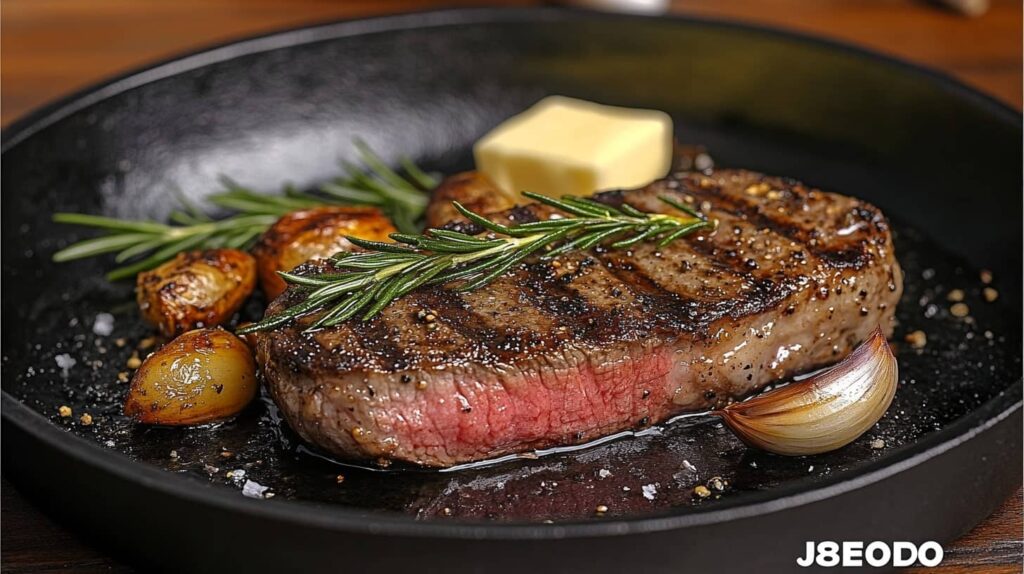Table of Contents
Have you ever come across the term “Delmonico Steak” and wondered what makes it so special? Well, you’re in for a juicy treat! This guide dives deep into the world of Delmonico steak, from its rich history to how you can cook it like a seasoned chef. Whether you’re a foodie or just someone who loves a good steak dinner, there’s plenty here to sink your teeth into. 🍽️
What is a Delmonico Steak?
Let’s clear up the confusion right away. A Delmonico steak isn’t just one specific cut of beef—it’s more of a concept than a strict definition. The term traces back to the famous Delmonico’s restaurant in New York City, where the chefs served a luxurious, thick-cut steak known for its tenderness and rich flavor. But here’s the kicker: different butchers and chefs have their own interpretations of what a Delmonico steak is!
“The Delmonico steak is not a single cut of meat but a promise of high quality and exceptional flavor.”
The History and Origin of Delmonico Steak
Picture this: it’s the mid-1800s in New York City. Delmonico’s restaurant is the talk of the town, known for its lavish dishes and high standards. They created a steak so good that it became legendary, and diners couldn’t stop raving about it. The name stuck, and now, over a century later, people still associate “Delmonico” with premium quality beef.
Understanding the Unique Characteristics of Delmonico Steak
What sets Delmonico steak apart? It’s thick, juicy, and heavily marbled. This marbling (those little white streaks of fat) gives the steak its signature tenderness and mouthwatering flavor. Think of it as nature’s butter melting into the meat as it cooks. 😋
Delmonico Steak vs. Ribeye: Key Differences
Let’s settle a common debate: is Delmonico steak the same as ribeye? Nope! While they share similarities, there are a few key differences:
Texture and Marbling Comparison
Ribeye is known for its abundant marbling, making it super tender and flavorful. Delmonico, on the other hand, can come from various cuts, so its texture and marbling may vary. Some Delmonico steaks are leaner, while others rival ribeye in richness.
Flavor Profile and Cooking Preferences
Ribeye tends to have a buttery, beef-forward taste that melts in your mouth. Delmonico steak is a bit of a wildcard—it can be just as indulgent or slightly firmer, depending on the cut. The cooking method also plays a huge role in how the flavors shine.
Choosing the Perfect Cut for Delmonico Steak
Here’s where things get interesting. Since Delmonico steak isn’t tied to a single cut, you’ve got options. It could be a ribeye, a strip steak, or even a sirloin, depending on where you shop.
Different Cuts Marketed as “Delmonico Steak”
When you’re at the butcher or grocery store, you might see several cuts labeled as Delmonico. Popular choices include:
- Ribeye (boneless or bone-in)
- Top sirloin
- Chuck eye steak
Each cut has its own unique texture and flavor, so pick based on your preference.
How to Select Quality Meat from the Butcher
Here’s a tip: always look for bright red meat with a good amount of marbling. Avoid steaks that look dull or have too much liquid in the packaging—it’s a sign they might not be fresh. Don’t be afraid to ask your butcher for advice. After all, they’re the steak experts! 🥩
How to Cook a Delmonico Steak Like a Pro
Cooking the perfect Delmonico steak isn’t as intimidating as it sounds. Follow these steps, and you’ll be impressing your dinner guests in no time:
Preparing the Steak: Seasoning and Marinades
Less is more when it comes to seasoning. A simple blend of salt, pepper, and garlic powder is all you need to let the natural flavors shine. If you’re feeling adventurous, a quick marinade with olive oil, rosemary, and balsamic vinegar can add a zesty twist.
Best Cooking Methods: Grilling, Pan-Seared, or Broiled?
Here’s the deal: there’s no “right” way to cook a Delmonico steak. It depends on your tools and taste preferences. Want smoky char marks? Fire up the grill. Craving a crispy crust? Sear it in a hot cast-iron skillet. Feeling fancy? Broil it for a restaurant-quality finish.
Step-by-Step Guide to Achieving Perfect Doneness
- Take the steak out of the fridge and let it sit at room temperature for about 30 minutes.
- Season both sides generously with your seasoning of choice.
- Preheat your cooking surface (grill, skillet, or oven) to high heat.
- Sear the steak for 2–3 minutes per side to lock in the juices.
- Lower the heat and cook until your desired doneness. Use a meat thermometer to be precise!
| Doneness | Temperature |
|---|---|
| Rare | 120–125°F |
| Medium Rare | 130–135°F |
| Medium | 140–145°F |
| Well Done | 160°F+ |
Common Cooking Mistakes and How to Avoid Them
Ever had a steak turn out dry or chewy? The usual culprits are overcooking, under-seasoning, or skipping the all-important resting step. Letting the steak rest for 5–10 minutes after cooking allows the juices to redistribute, keeping every bite tender and flavorful.
Popular Delmonico Steak Recipes
Ready to bring the restaurant-quality experience home? These recipes will have you cooking Delmonico steak like a pro. Whether you love traditional flavors or want to experiment with new twists, there’s something here for everyone.
Classic Delmonico Steak Recipe
This recipe keeps it simple, highlighting the natural flavors of the steak. Here’s what you’ll need:
| Ingredient | Quantity |
|---|---|
| Delmonico steak | 2 (1.5-inch thick) |
| Salt | 1 teaspoon |
| Black pepper | 1 teaspoon |
| Garlic powder | 1 teaspoon |
| Butter | 2 tablespoons |
| Fresh rosemary | 2 sprigs |
Instructions:
- Preheat your skillet or grill to high heat.
- Season the steaks generously with salt, pepper, and garlic powder.
- Place the steaks on the hot surface and sear for 2–3 minutes on each side.
- Reduce the heat to medium and add butter and rosemary to the skillet.
- Baste the steaks with the melted butter and cook to your desired doneness (refer to the temperature guide in Part 1).
- Remove the steaks from the heat and let them rest for 5–10 minutes before serving.
Modern Takes on Delmonico Steak
If you’re in the mood to get creative, try these variations:
- Delmonico Steak with Chimichurri: Top your steak with a vibrant chimichurri sauce made from parsley, garlic, olive oil, and vinegar.
- Asian-Inspired Delmonico: Marinate the steak in soy sauce, ginger, and sesame oil for an umami-packed twist.
- Garlic Parmesan Crusted Delmonico: Coat the steak with a blend of breadcrumbs, garlic, and Parmesan before broiling for a crispy crust.
Pairing Ideas: Sides and Sauces for Delmonico Steak
What’s a steak dinner without the perfect accompaniments? Here are some ideas to complete your meal:
- Sides: Garlic mashed potatoes, roasted Brussels sprouts, or a fresh Caesar salad.
- Sauces: Béarnaise sauce, peppercorn sauce, or a classic red wine reduction.
Common Problems When Cooking Delmonico Steak and Their Solutions
Even the best cooks face challenges in the kitchen. Here are some common issues you might encounter and how to fix them:
Tough Steak: Causes and Fixes
Have you ever bitten into a steak that felt like chewing leather? That’s likely due to overcooking or choosing a cut with insufficient marbling. To avoid this, use a meat thermometer to cook to the perfect temperature and opt for a well-marbled cut.
Overcooking and How to Avoid It
Steak can go from perfect to overdone in seconds. The key is to keep a close eye on the temperature and remove the steak from the heat a few degrees before it reaches your target doneness. The residual heat will finish the job!
Maintaining Juiciness and Flavor During Cooking
Nothing’s worse than a dry steak. To keep it juicy, don’t skip the resting step. This allows the juices to redistribute, making every bite deliciously moist.
Tips for Perfecting Your Delmonico Steak Every Time
Want to take your steak game to the next level? These tips will help you achieve steakhouse-quality results:
Choosing the Right Tools and Equipment
Invest in a good-quality cast-iron skillet and a reliable meat thermometer. These tools are game-changers when it comes to achieving consistent results.
The Importance of Resting the Steak
We’ve mentioned it before, but it’s worth repeating: always let your steak rest after cooking. Think of it as a “cool-down” period where all the flavors lock in, making every bite amazing.
Experimenting with Flavors and Techniques
Don’t be afraid to try new things! Play around with marinades, spice blends, and cooking methods until you find what works best for you. Cooking is an art, after all.
Nutritional Information and Benefits of Delmonico Steak
Curious about what’s in your steak? Here’s a quick breakdown:
| Nutrient | Amount |
|---|---|
| Calories | 400 |
| Protein | 30g |
| Fat | 28g |
| Saturated Fat | 12g |
| Iron | 20% DV |
Balancing Delmonico Steak in a Healthy Diet
While steak is rich in protein and nutrients, moderation is key. Pair it with plenty of veggies and whole grains for a balanced meal.

Frequently Asked Questions
Why Is It Called Delmonico Steak?
The name comes from Delmonico’s restaurant in New York City, where this luxurious steak first became famous.
Is Delmonico Steak Worth the Price?
Absolutely! When cooked properly, it delivers a dining experience that’s hard to beat.
Can You Cook Delmonico Steak in an Air Fryer?
Yes, you can! Just preheat your air fryer to 400°F, season the steak, and cook for about 12–15 minutes, flipping halfway through.
Last Bite
Now you’ve got everything you need to become a Delmonico steak expert! From understanding its history to perfecting your cooking techniques, the only thing left to do is fire up your grill or skillet and give it a try. Remember, practice makes perfect—and delicious. 🥩✨

